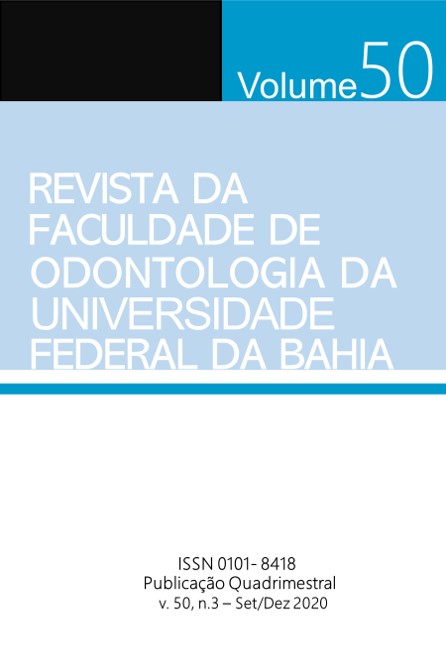AGEUSIA E ANOSMIA NA COVID-19: MANIFESTAÇÕES DE INTERESSE NA ODONTOLOGIA AGEUSIA AND ANOSMIA IN COVID-19: EXPRESSIONS OF INTEREST IN DENTISTRY
DOI:
https://doi.org/10.9771/revfo.v50i3.43113Palavras-chave:
COVID-19, SARSCoV- 2, olfato, paladar, smell, taste.Resumo
Introdução: Em dezembro de 2019, identificou-se um novo coronavírus
(SARS-Cov-2), em Wuhuan, China, o qual foi considerado como o agente
etiológico da doença pelo coronavírus 2019 (COVID-19). Conjuntamente
com os principais sintomas característicos da doença, a perda do olfato,
anosmia, e a perda de paladar, ageusia, vêm sendo descritos como queixas
recorrentes em pacientes testados positivos para essa patologia. Objetivo:
Discorrer sobre a disfunção do olfato e paladar, manifestações de
interesse odontológico, como sintomatologias associadas à COVID-19.
Revisão de Literatura: Desde o início da pandemia, alguns estudos
demonstraram forte associação entre a infecção pelo SARS-CoV-2 e o
comprometimento olfativo e gustativo. Dentre os mecanismos patogênicos
associados a esses sintomas, durante a fase inicial da COVID-19, sugere-
se que o receptor da enzima conversora de angiotensina 2 e a protease
transmembranar, serina 2 (TMPRSS) sejam expressos no epitélio olfativo
e nas células epiteliais da mucosa da cavidade oral, sendo utilizado pelo
vírus para aderir e penetrar na célula hospedeira, promovendo as alterações
sensoriais. Considerações Finais: Relatos de alterações olfativas e
gustativas, de forma precoce e em quadros brandos, são frequentes, caracterizando-
se em muitos casos, como a primeira manifestação clínica ou
única da doença. O cirurgião-dentista desempenha papel essencial no
diagnóstico desses sintomas, pois estes podem ser vistos de forma recorrente
na sua prática clínica, além de se configurarem como possíveis marcadores
de diagnóstico precoce da COVID-19.
Introduction: In December 2019, a new coronavirus (SARS-Cov-2) was
identified in Wuhuan, China, which was considered as the etiologic agent
of the 2019 coronavirus disease (COVID-19). Together with the main char
acteristic symptoms of the disease, loss of smell, anosmia, and loss of
taste, ageusia, have been described as recurrent complaints in patients
tested positive for this pathology. Objective: To discuss the dysfunction
of smell and taste, expressions of dental interest, such as symptoms associated
with COVID-19. Literature Review: Since the beginning of the pandemic,
some studies have shown a strong association between infection
by the new coronavirus and olfactory and gustatory impairment. Since the
beginning of the pandemic, some studies have shown a strong association
between SARS-CoV-2 infection and olfactory and gustatory impairment.
Among the pathogenic mechanisms associated with these symptoms,
during the initial phase of COVID-19, it is suggested that the angiotensin-
converting enzyme receptor 2 and the transmembrane protease, serine
2 (TMPRSS) be expressed in the olfactory epithelium and epithelial
cells of the mucosa of the oral cavity, being used by the virus to adhere
and penetrate the host cell, promoting sensory changes. Final Considerations:
Reports of olfactory and gustatory changes, in an early form and in
mild cases, are frequent, characterized in many cases as the first clinical or
single manifestation of the disease. Dentists play an essential role in the
diagnosis of these symptoms, as they can be seen recurrently in their clinical
practice, in addition to being configured as possible markers of early
diagnosis of COVID-19.
Downloads
Downloads
Publicado
Como Citar
Edição
Seção
Licença
Copyright (c) 2021 Revista da Faculdade de Odontologia da UFBA

Este trabalho está licenciado sob uma licença Creative Commons Attribution-NonCommercial 4.0 International License.

